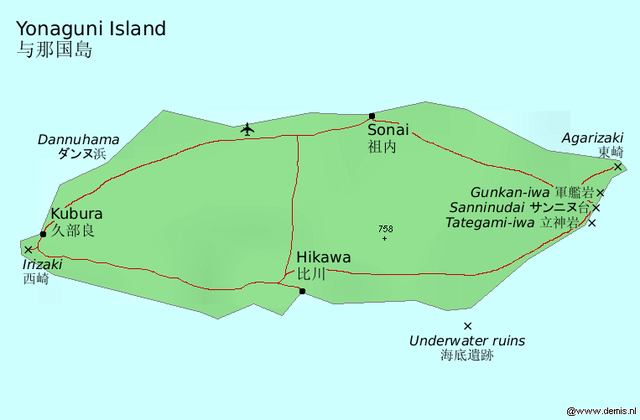Top Qs
Timeline
Chat
Perspective
Yonaguni language
Southern Ryukyuan language From Wikipedia, the free encyclopedia
Remove ads
The Yonaguni language (与那国物言/ドゥナンムヌイ Dunan Munui) is a Southern Ryukyuan language spoken by around 400 people on the island of Yonaguni, in the Ryukyu Islands, the westernmost of the chain lying just east of Taiwan.[3] It is most closely related to Yaeyama. Due to the Japanese policy on languages, the language is not recognized by the government, which instead calls it the Yonaguni dialect (与那国方言, Yonaguni hōgen). As classified by UNESCO, the Yonaguni language is one of the most endangered languages in all of Japan, after the Ainu language.
This article needs additional citations for verification. (November 2024) |
Remove ads
Phonology
Summarize
Perspective
Vowels
The table below shows the vowels present in the Yonaguni language. Vowels which are only allophonic or marginal appear in parentheses.
- ^a [o] can also be recognized as an independent phoneme and not just as an allophone of /u/. However, its distribution is very limited. Excluding a few interjections, the only morpheme in which it appears is the sentence-final, exclamatory particle do.
Consonants
The table below shows the consonants present in the Yonaguni language.
Plosive and affricate phonemes have three-way contrast. Hirayama et al. (1967) describe the contrast as voiceless non-laryngealized, voiceless laryngealized, and voiced.[5] Yamada et al. (2015) describe the contrast as fortis (unaspirated and tense), lenis (weakly aspirated and lax), and voiced. The lenis/fortis distinction neutralized in word-medial positions, both becoming phonetically fortis.[4]
In positions other than prevocalic, all nasals are phonetically homorganic with a following consonant (e.g. ng [ŋɡ], nd [nd], nb [mb]). Nasals are velar ([ŋ]) in final position.[4]
Phonological cognates
As a Southern Ryukyuan language, Yonaguni, similar to Miyakoan and Yaeyama, has /b/ in place with Standard Japanese /w/, such as Yonaguni /bata/ ('stomach, belly'), cognate with Japanese /wata/ ('guts, bowels'). Yonaguni also has /d/ where Japanese and other Ryukyuan languages have /j/ (orthographically y). Thus, for example, Yonaguni /dama/ ('mountain') is cognate with Japanese and Yaeyama /jama/ ('id.'). Yonaguni /d/ is probably a recent development from an earlier */j/, however, judging from the fact that even the */j/ in loanwords of Sinitic origin is pronounced /d/ by speakers of the Yonaguni language, such as dasai 'vegetables' from Middle Chinese *jia-tsʰʌi (野菜). An entry in the late-15th-century Korean annals Seongjong Taewang Sillok records the local name of the island of Yonaguni in Idu script as 閏伊是麼, which has the Middle Korean reading zjuni sima, with sima glossed in the text as the Japonic word for 'island'. That is direct evidence of an intermediate stage of the fortition *j- > *z- > d-, leading to the modern name /dunaŋ/ 'Yonaguni'.[6]
The Yonaguni language exhibits intervocalic voicing of plosives, as do many Japonic languages. It also exhibits the tendency for /ɡ/, especially when intervocalic, to be pronounced as a velar nasal /ŋ/, as in Standard Japanese.
Syllable structure
Below is the syllable template for Dunan:
- (C (G) ) V1 (V2) (N)
- C = consonant
- G = glide [w] or [j]
- V = vowel
- N = moraic nasal
The onset allows for a single consonant with the occasional presence of a glide. The nucleus can contain up to two vowels. The only allowable coda is a moraic nasal.
Remove ads
Writing system
Summarize
Perspective
Yonaguni was once written with a unique writing system called Kaidā logograms. However, after conquest by the Ryukyu Kingdom and later annexation by the Empire of Japan, the logograms were replaced by Japanese kana and Kanji.[7][failed verification]
* /m/ before labial consonants and /ŋ/ before velar consonants. Example ディンブンキルン [dimbuŋkirun] "to have a goal for".
Remove ads
References
Further reading
External links
Wikiwand - on
Seamless Wikipedia browsing. On steroids.
Remove ads


